First published July 2017 | Words and photos by Vietnam Coracle | 28 comments
This post was last updated 8 years ago. Please check the comments section for possible updates, or read more on my Updates & Accuracy page.
INTRODUCTION | GUIDE | MAP | MORE POSTS
Lying in the calm, warm waters of Van Phong Bay, just an hour north of Nha Trang, Diep Son is a mini-archipelago of small green islands. At low tide, a curving sandbar is exposed, linking three of the islets via a ‘sand bridge’. The long sweep of white sand between the three green islands in the blue bay is very picturesque. Although Diep Son is increasingly popular with domestic tour groups, it’s best visited independently, because this way you can avoid the crowds. Travel to Diep Son is an easy combination of road and sea transport between Nha Trang city, Van Gia village, and Hon Bip island. Diep Son makes a good day trip from Nha Trang, or as part of a wider exploration of Van Phong Bay and the surrounding area (see Related Posts). A great option for budget travellers is to spend the night on Hon Bip island in a tent or bamboo hut on stilts above the water.

In the calm waters of Van Phong Bay, the islands of Diep Son are linked by a ‘sand bridge’
[Back Top]
GUIDE: DIEP SON ISLAND & SANDBAR
I’ve written the following guide as a travelogue, including practical information about transportation, prices, accommodation, food, drink, and things to see and do along the way, as well as my map of the area. The following paragraphs break down into four sections:

MAP:
Diep Son Island & Van Gia Town, Van Phong Bay
View in a LARGER MAP
[Back Top]
Nha Trang to Van Gia:
Not long ago, one of the many drone cameras showcasing Vietnam’s natural beauty from above, flew over Diep Son. The resulting video went viral on Facebook: everybody wanted to know where Diep Son was and how to get there. Now, hundreds of people take the boat across Van Phong Bay, from Van Gia to Diep Son, every day. The vast majority are domestic travellers – either as part of a group tour or phượt (independent road-trippers). This means that, on the one hand, getting to Diep Son is pretty easy and hassle-free, but on the other hand, you feel like you’re on an organised tour. However, if you travel at the right time of day and, especially, if you stay the night on the island, it’s still a very rewarding, scenic, and worthwhile trip.
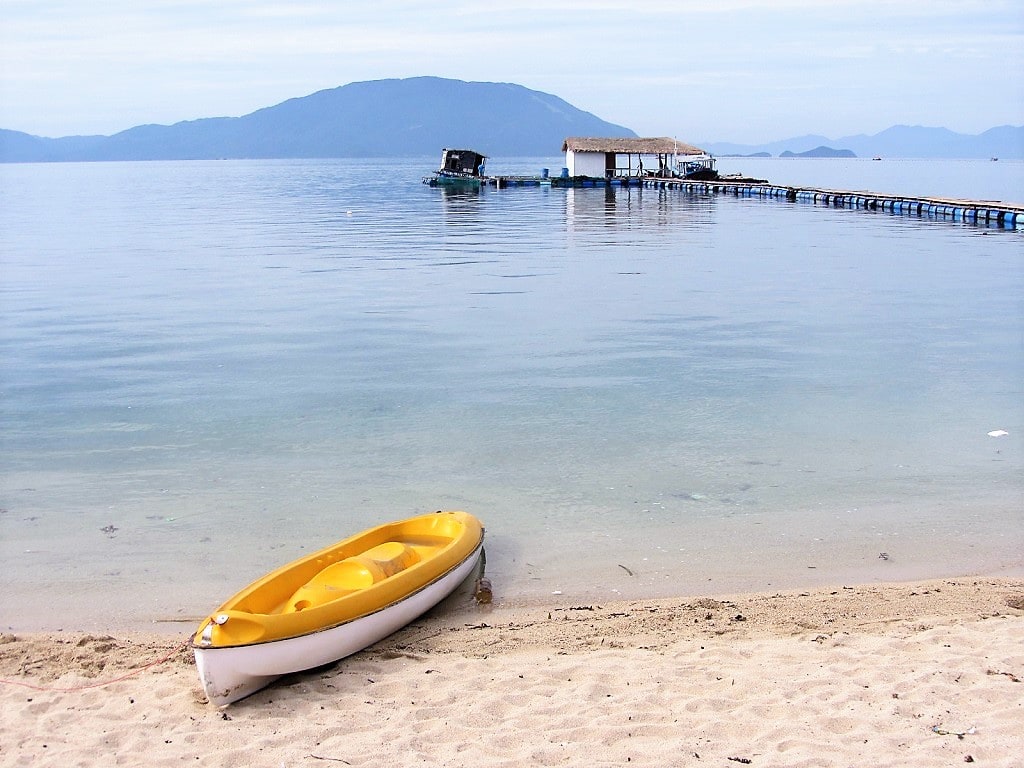
Despite a dramatic rise in visitor numbers, it’s still possible to avoid the crowds on Diep Son Island
Although most hotels and guest houses in Nha Trang can arrange a tour to Diep Son, I recommend doing it independently. There are several daily local buses between Nha Trang, Ninh Hoa and Van Gia, from where you can walk to the port on the seafront to get the boat to Diep Son (inquire about bus times at your hotel in Nha Trang or at the Nha Trang bus station). However, by far the most exciting way to get to the port at Van Gia is by motorbike (or, if you have the time and energy, by bicycle). If you don’t already have a motorbike, most accommodations in Nha Trang can arrange rental for a day or more (100,000-200,000vnd per day).

Tour buses disgorge passengers at Van Gia ferry pier: it’s better to go independently
The drive from Nha Trang to Van Gia is mostly on Highway 1, which, although heavily used by trucks, is in good condition at the moment, making the journey a smooth, scenic, relatively low-stress 60 to 90-minute drive. Van Gia is 60km north of Nha Trang, located on the coast at the centre of Van Phong Bay. The attractive seafront road (Tran Hung Dao) is lined with swaying coconut palms, under which wooden fishing boats bring in the night’s catch and undergo repairs. The road is dotted with shady cafes, eateries and a few mini-hotels. At the middle of the waterfront, Van Gia port (cảng Vạn Gĩa) is where boats leave for Diep Son (look for a large sign saying Điệp Sơn Quán [Diep Son Restaurant]).

Van Gia’s seafront is a pleasant place where fishing boats cluster & receive repairs under palm trees
Exploring Van Gia:
Van Gia is only used as a transport hub for boat connections to Diep Son. But, if you have a night to spare, it’s not a bad idea to spend it here. Van Gia is an interesting little place that is, in all probability, on the cusp of major development, thanks to its position in the middle of the bay and proximity to the islands. Indeed, the new seafront road was surely constructed with this in mind. However, it still has a refreshingly local feel. (At some point, many years ago, this must have been what Mui Ne felt like, before the arrival of mass tourism.) Local people are friendly, the backstreets are dotted with cute little red-tiled homes, the harbour is full of fishing boats, and the main town (a few blocks back from the sea) has everything you need: banks, street food, a supermarket, motorbike garages.

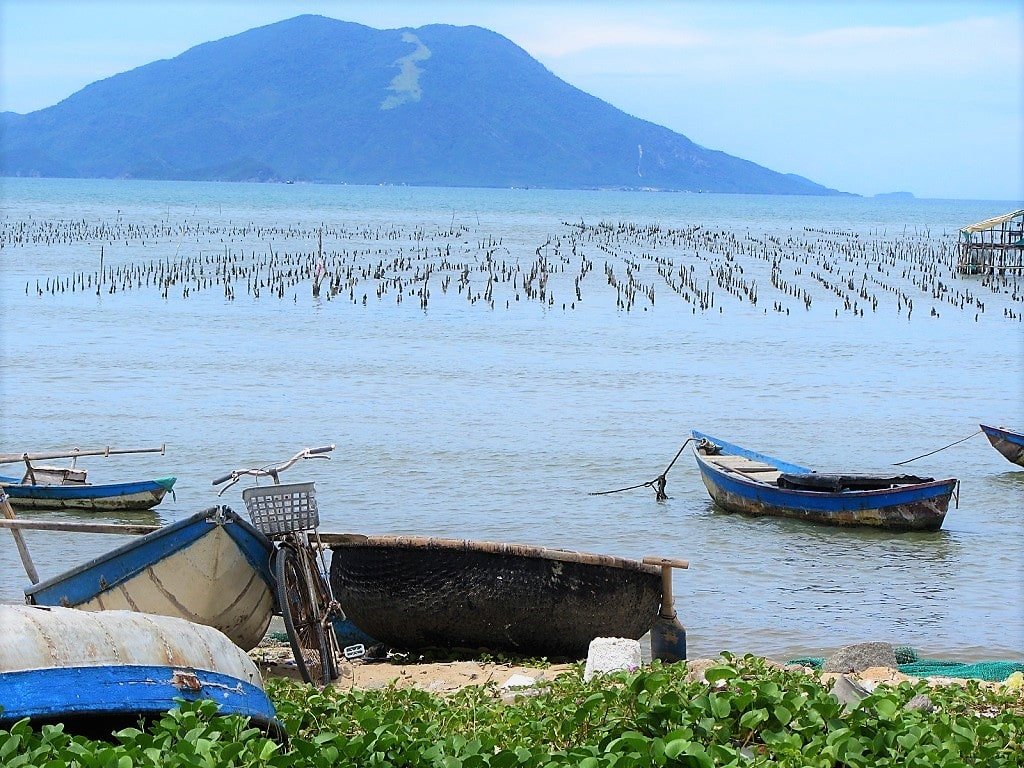
Van Gia has a great location at the centre of Van Phong Bay: it’s worth staying a night
A sleepy town during the day, Van Gia’s seafront comes alive in the late afternoons and early evenings, when the sun is low, the light pink, and the breeze is wonderfully refreshing; children frolic in the surf and play in the sand, while parents and lovers lie back in deck chairs under the trembling sails of coconut palms, munching on hot snacks served from illuminated food carts, and sipping freshly pressed sugar cane juice….and everybody leaves their trash strewn over the sand or thrown into the sea (sigh). Good-value rooms are available at all the nhà nghỉ (local guest houses) and mini-hotels along the seafront road, from where it’s a short walk to the boat pier. The standard price is 250,000vnd for a clean, plain room with a window and hot water shower. I like Gia Huy Hotel (2 Tran Phu Street; 0583 708 686). Nha Nghi Phuong Hoang (0122 553 7707) has two locations, including one conveniently located directly opposite the boat pier, but they were very rude to me.
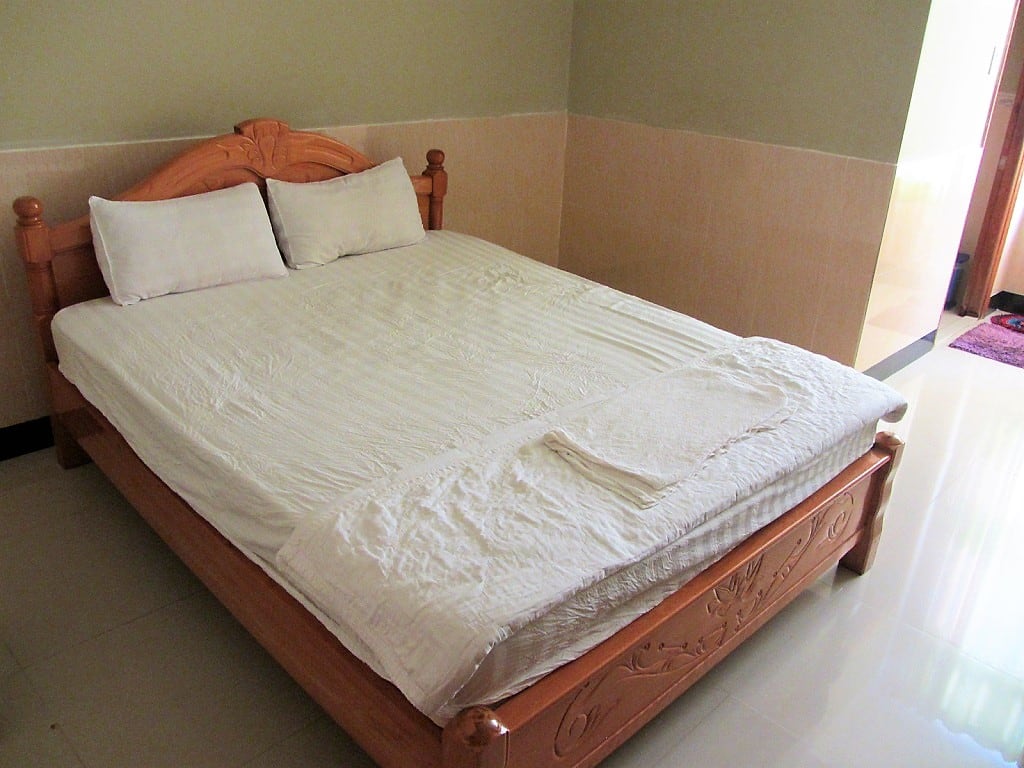
Budget hotels line the waterfront road: this is Gia Huy Hotel; 250,000vnd a night
Seafood is served in several eateries along Tran Hung Dao and there are a couple of good cafes on the backstreets leading from the seafront, including the lush Cafe Moc. Don’t miss Ms Hậu’s bánh căn (spongy, savoury rice flour and quail egg cakes dipped in ‘special sauce’) under a tree on the corner of Tran Hung Dao and Nguyen Binh Khiem streets (11am-4pm; 10,000vnd per 10 cakes).

Pay a visit to Ms Hậu’s bánh căn stall for a delicious & filling local snack during the day
Van Gia to Diep Son by Boat:
Another advantage of staying the night in Van Gia is that you can catch an early boat to the islands the next morning. Buying a ticket is quite easy and well-organized. Tables selling tickets set up by the port, under the shade of a large tree, next to the ‘Điệp Sơn Quán’ signpost. You can’t really miss it, because there will be coaches and minivans all around. Boats leave at regular intervals from 7am till lunchtime (around midday). As the afternoon progresses, there are fewer boats leaving to the islands, because, by that time of day, most day-trippers are on their way back from the islands to Van Gia.
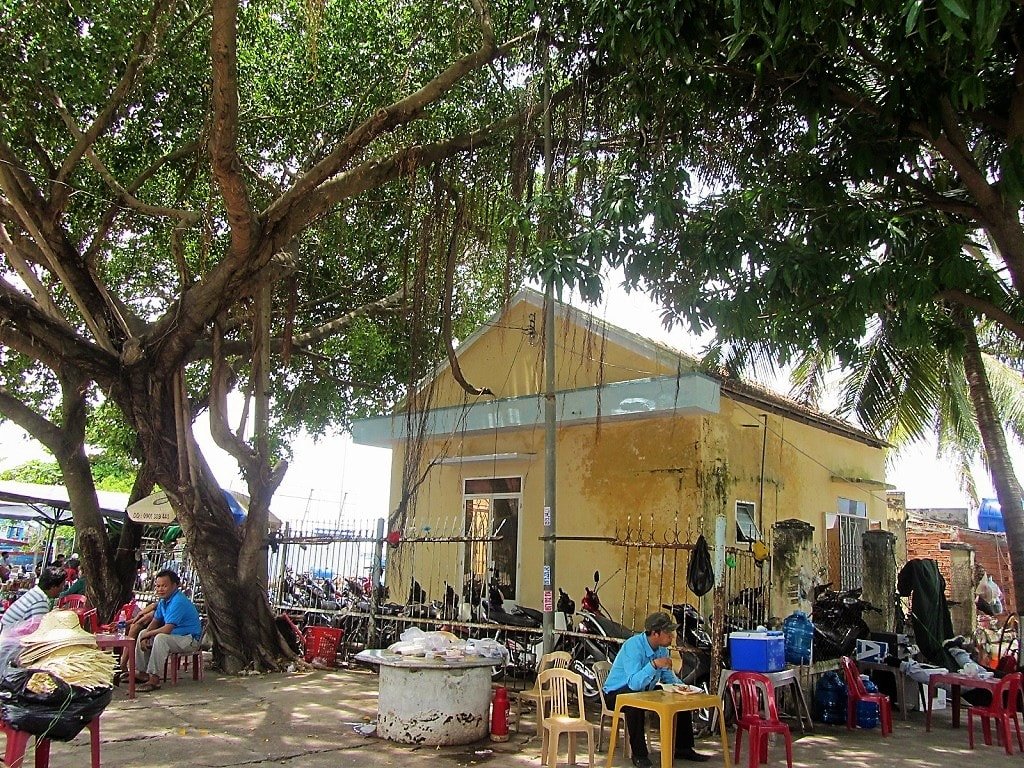
Boat tickets are sold from plastic tables set under a tree on Van Gia’s waterfront
There are two kinds of boats: fast speed boats (and they really are fast), and much slower wooden boats. Tickets for the fast boats are 200,000vnd return and journey time is 10-15 minutes. Tickets for the slow boats are 100,000vnd return and the journey takes at least 30-45 minutes. As an independent traveller, it’s generally best to get the fast boat, as most of the slow boats cater to large tour groups who meander their way from Van Gia via other sights in the bay before arriving at Diep Son. (You may need to show your passport when buying a boat ticket, although I’ve never been asked to.) All boats are for passengers only: there are not vehicles, of any kind, allowed. If you have a motorbike or bicycle, you can park it securely at one of several giữ xe (parking lots) opposite the boat pier (10,000vnd per day; 20,000vnd overnight: don’t lose your parking ticket).


The fast boat is the best option: 200,000vnd return; the journey takes 10-15 minutes
Most large tour groups turn up at the dock between 7am and 8am, during which time it can get busy. However, this is not a bad time to go to the islands, because many of the groups take the slow boats on organized tours that visit other islands in the bay, before arriving at lunchtime for a seafood meal on Diep Son. Therefore, by taking the fast boat from Van Gia direct to Diep Son at 7.30am, for example, you will have at least a couple of hours on the island before the bulk of the tour groups arrive for lunch. (Another reason most tours time their arrival on Diep Son at lunchtime is that this is when the tide is low and the sandbar is most exposed.)
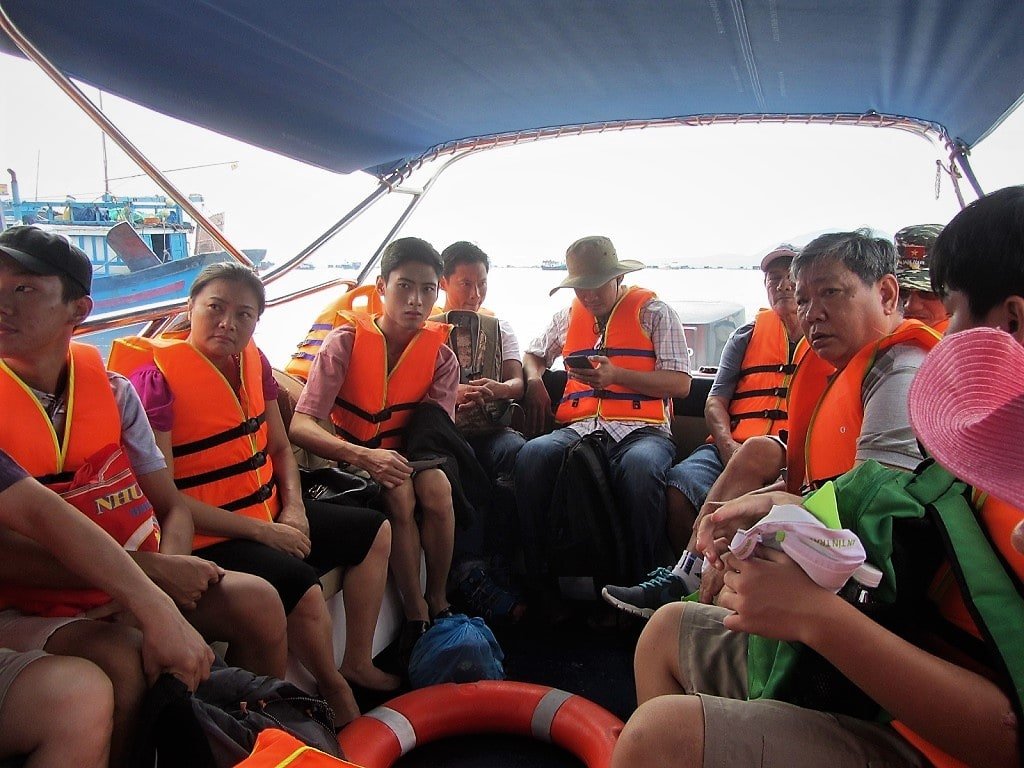
The fast boats can accommodate around 20 passengers; life vests are provided
The speedboats can accommodate around 20 passengers and, in theory at least, won’t leave until they are at least half full. In the mornings (peak time), you’re unlikely to have to wait for the boats to fill up, as there will be dozens of people waiting to board. But, in the afternoons, boats are less likely to sail with only a few passengers. The speed boats appear to be fairly modern and are equipped with life vests. However, Vietnam’s maritime safety record is appalling, and some of the boat drivers are disgracefully irresponsible: on one of the boats I was on, despite having a frail octogenarian seated at the front, the driver went as fast as he could, cutting in front of every vessel he overtook as close as possible to their hulls, and directing the boat into as much rough surf as he could. Fortunately, it’s all over in a blur, because the boats are so swift, but this is something to bear in mind if you don’t have good sea legs.

Arrival at Diep Son Island is at a long pontoon pier, leading directly to the beach & sandbar
Diep Son Island & Sandbar:
Most of the boats moor at a long pontoon pier on Diep Son Island (also known as Hon Bip), the largest of the three islands in the mini-archipelago. Some boats also dock at Diep Son hamlet, which is just a short walk from the pontoon pier. (For the return journey, boats leave whenever there are a handful of passengers to take back to Van Gia. However, it’s difficult to get a return boat in the late afternoon). If you arrive in good weather, the island is a beautiful sight, rising from the flat, silky waters of Van Phong Bay, ringed with sandy beaches, one of which stretches out to sea in a curve, forming a sand bridge to the other islands, for which Diep Son is famous. For Vietnamese tourists, this is selfie heaven, and the majority of visitors tend to spend most of their time on the island posing for social media-bound photos.
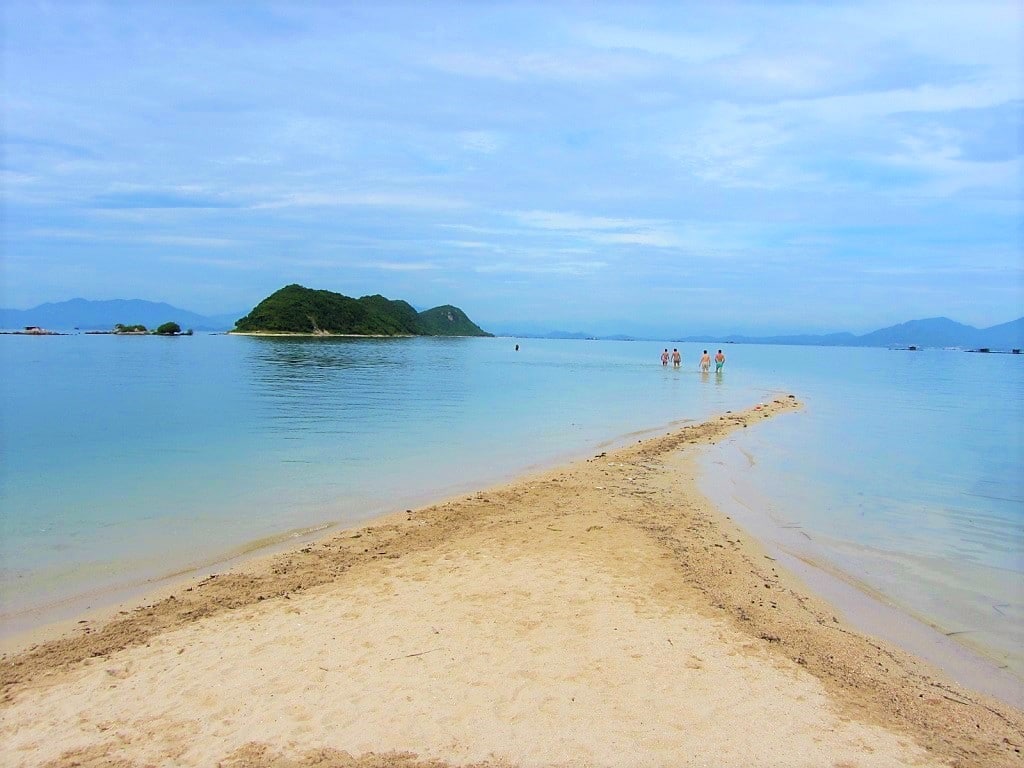
Walking across the sandbar connecting Diep Son’s three islands is the main attraction
There’s not much in the way of infrastructure on the island yet. A generator provides electricity throughout the day until about 7pm. A long, palm-thatched restaurant serves decent and quite reasonably-priced meals (including seafood) and drinks, as well as offering water sports, such as kayaking (a lot of fun on these calm waters), jet skis, snorkeling, and fishing. There are a couple of isolated drink and snack shacks on the other two smaller islands (accessed on foot via the sand bridge). At the time of writing, there were several other small-scale developments underway on all three of the islands, so expect a lot of changes over the next year or two.
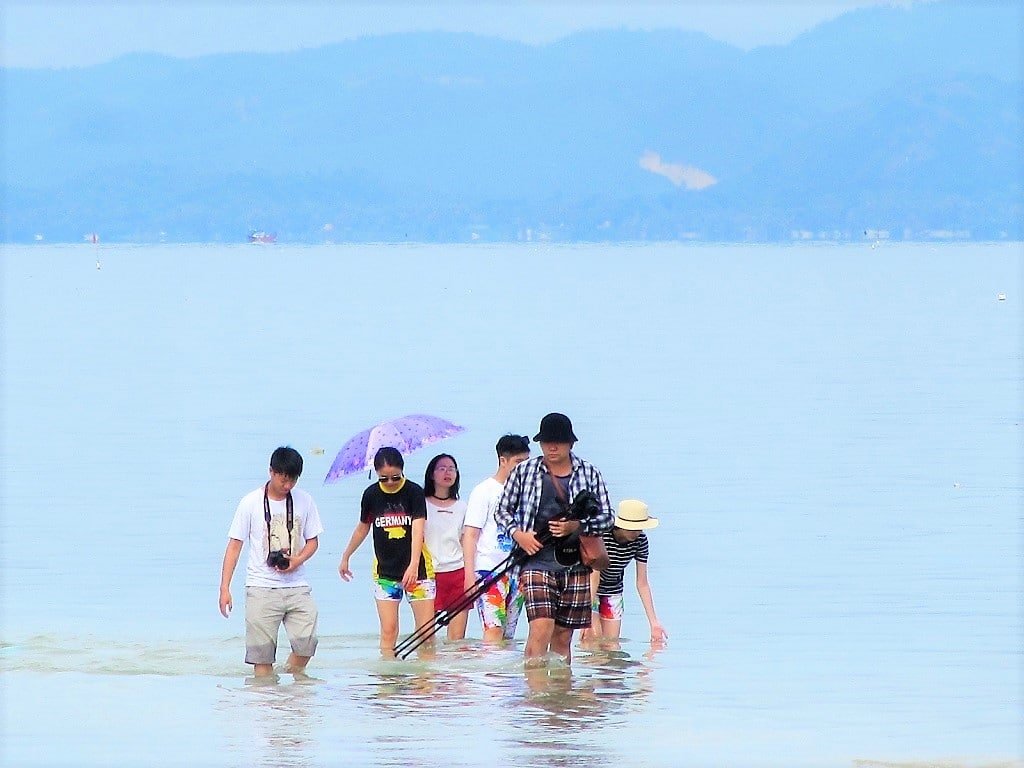
The sandbar is a popular place for group photographs: it’s most exposed in the afternoons
Swimming is good. The water is shallow and calm so most people feel confident about taking a dip and, the main attraction, wading across the partially submerged sandbar to the two smaller islands. The water quality is still fine, although there’s an increasing amount of garbage lying in the surf, because day-trippers, who often bring their own picnics, tend to discard their trash by simply leaving it on the sand or throwing it in the sea (and there’s a fair amount of fishermen’s detritus too). However, trash has yet to overwhelm and ruin Diep Son as it has other popular sights in Vietnam: it’s hanging on, but it’s very fragile indeed. The interior of the islands is green, but also rocky and arid. Near the coastline, there are mango and calabur cherry trees, but further inland these are replaced by cacti, eucalyptus and, intriguingly, volcanic rock.
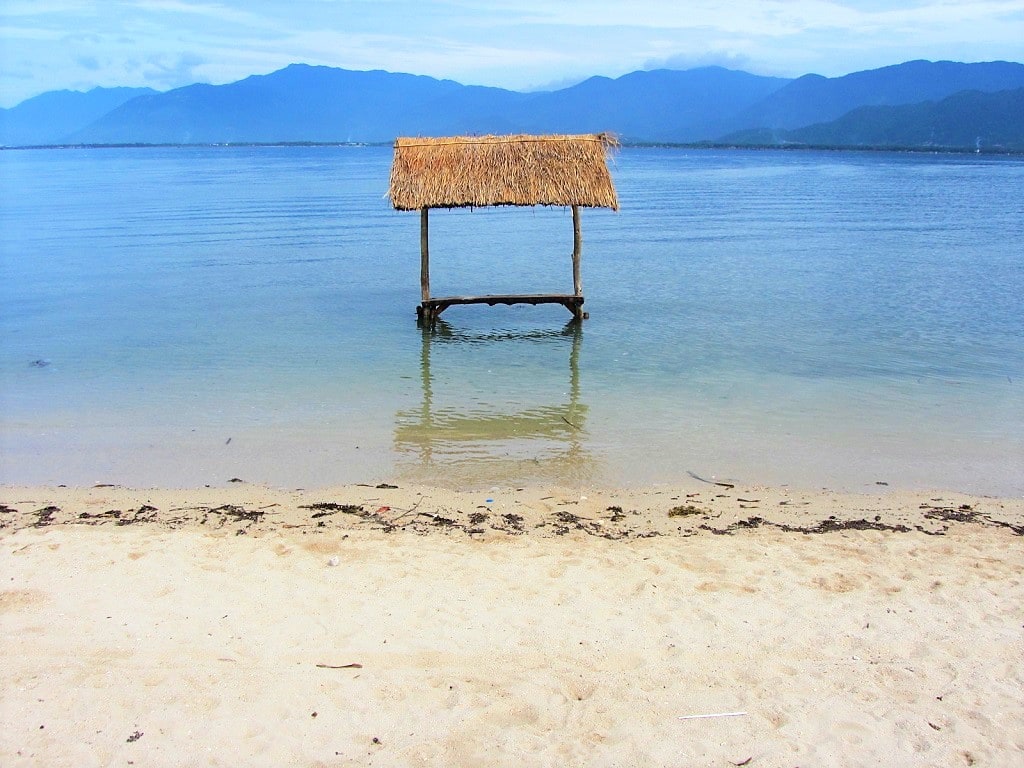
The water is calm & blue around the sandbar, making it good for swimming & kayaking
If you want to experience Diep Son without the ‘selfie hordes’ and tour groups, consider staying the night on the island. Accommodation is basic but atmospheric and very reasonably priced. Choose between a rented two-man dome tent on the beach (200,000vnd for two people) or a mattress under a mosquito net in a bamboo cabin raised on stilts over the water (400,000vnd for two people). Or, you can even bring your own tent and pitch it anywhere on the beach for free. Do this and you’ll have the entire island practically to yourself for the evening, night and early morning (unless a group of phượt travellers are also camping, but they’re usually young and good, fun company). Showers and bathrooms are OK, and the restaurant can serve you dinner and breakfast. Accommodation is arranged at the Diep Son Restaurant (0914 39 39 79) at the end of the pontoon pier.
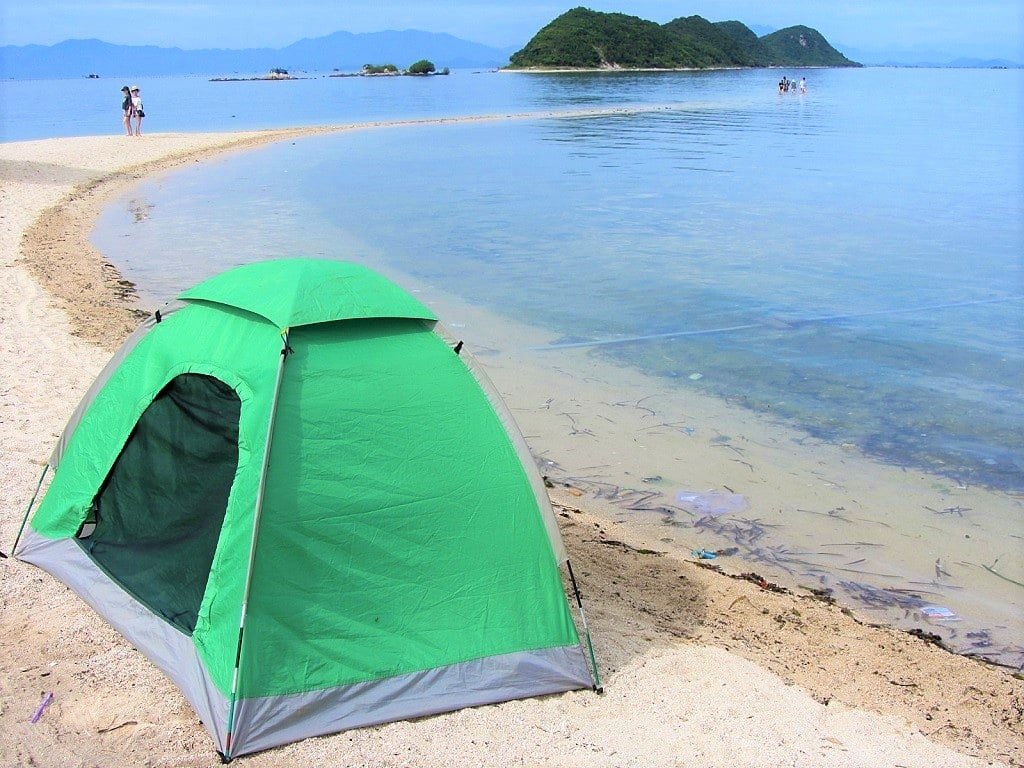
To get the most out of a visit to Diep Son, spend the night on the island: in tent or a cabin
Diep Son is, without doubt, a beautiful place and worthy of its new-found fame. While I was waiting for the boat to leave Van Gia dock, watching busloads of tourists arriving from Nha Trang, I was worried that the islands would be too crowded (and too littered). But this turned out not to be the case, at least until lunchtime. And, although litter is a problem here (as it is in almost every popular tourist destination in Vietnam), it wasn’t bad enough to spoil the experience, and there were some encouraging signs of people clearing up their own trash. If you stay the night on Hon Bip Island you will almost certainly enjoy the experience, but if you happen to hit the island and the wrong time of day, you may be disappointed. However, there’s something temporary and even desperate about both the hastily-assembled infrastructure on the islands and the massive and sudden influx of domestic visitors: it’s almost as if everybody knows that this mini-archipelago is destined to fall into the hands of some huge, luxury developer, and so it’s crucial to visit now, before it becomes the preserve of the wealthy and the few.

Diep Son Island feels fragile and is bound to change dramatically over the coming years
RELATED POSTS:
[Back Top]

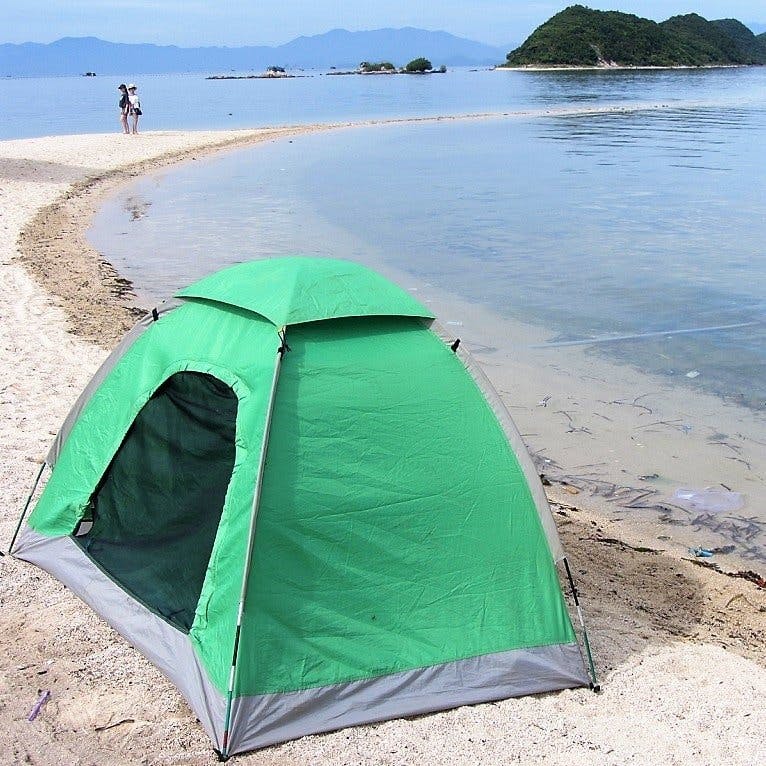
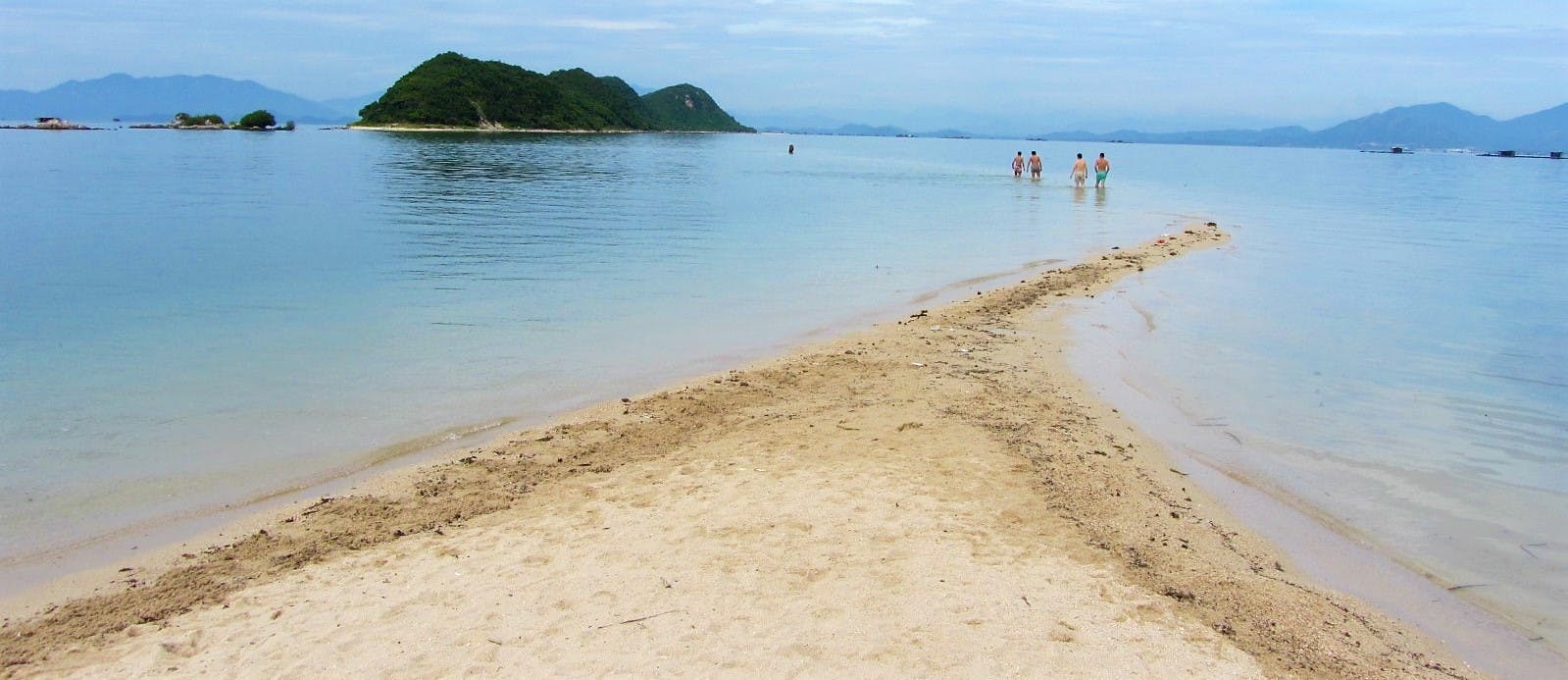
I visited Điệp Sơn on Day 4 of Tết 2024 snd had a very good experience. Spent the prior night at a friendly little hotel called Hoàng Giang then rode my motorbike to Vạn Giá port early the next morning. I was allowed to park my bike there for free. The earliest speed boat departure time was 9 am, but this was early enough to get to Điệp Sơn at a tide low enough to see most of the sandbar and walk it. (It pays to check the tide tables and time your arrival accordingly.) There is a nice new resort not far from the drop off point called Luzumi Beach where one can spend the night, and a little village to visit about 500 m from the resort. Speed boats routinely return to the mainland at 2 pm but you can go back at noon or so if there is sufficient demand. Plenty of food and drink on the island.
Hi Richard,
Thank you for the useful updates about Điệp Sơn. I was also near there for Tết and I intend to revisit Điệp Sơn a bit later this year to write a full update to this guide.
Best,
Tom
As Điệp Sơn was enjoyable even during the busy time of Tết I’m sure you’ll have a lovely visit.
After nearly one and a half years, I found the time to finally share my experience with visiting this place 😀
I went to Diep Son Island around Jan/Feb 2019, with the intention to sleep there. After getting to the smaller, southern-most island by speed boat in the morning, we spent some time having lunch in the huts where the boat left us and exploring the island. I enjoyed walking over to the middle island through the flat sea, but on there, there really is not anyting to do and the ground is quite uncomfortable to walk on so we came back to the first island quite soon 😉 We asked the restaurant owners if we could stay overnight and they confirmed, first offering us space in one of the huts between the pier of the boat and the restaurant. The huts did not look too comfy or clean, just some matresses on the floor and clearly just being used. We agreed nevertheless, but when we came back there in the evening to settle in, one guy working at the restaurant surprisingly drove us on his motorbike to the eastern side of the island. They had just build around five or six brandnew small holiday houses there and I feel like we were some of the first people to use them 😀 The houses were beautiful, big big window towards the sea, big double bed and everything brand new and modernly decorated. The toilet drainage didn’t work at the time so we had to use a bucket but that should be working by now 😉 We walked towards the southern end of the island to watch a beautiful sunset and were greated by an evenly stunning sunrise directly in front of our hut in the morning which we could watch lying in bed. I enjoyed the time at Diep Son a lot, it turned from being nice to being breath-taking. No idea how the situtation looks like now, and the pricing must have gone up as well (was around 10-15 Euro for one night then, I think) but from my experience, I can really recommend getting there and staying the night! 🙂
Hi Anne,
Thank you for sharing your experience of staying on Diep Son. It sounds very nice and I’m glad you got a chance to go there in the end. I look forward to visiting again too.
Tom
Thanks for the inspiring article!
We were in Van Gia in mid-December 2019. We tried to get an early boat to the islands, but there weren’t enough passengers (we were there mid-week). Eventually, we made it out to the islands by joining an organised tour from Nha Trang. We left at 10:15 and returned at 13:30. This was enough time for a leisurely walk across the sandbar and along a paved trail down to the southern tip of the south island and back. From the boat we saw several new-looking seaside cabins on the remote southern tip of the south island. The café/bar on the southern side of the sandbar was being cleaned up by a small crew, but not open.
Van Gia is a nice, relaxed town. The people were very friendly, the street food was fantastic and there’s just a nice vibe about the place. We stayed at the CocoSea on the beach road near the wharf. It’s a new hotel with doubles at the back (mountain view!) for 300k (VIP rooms for 4, with seaview and balcony, 600k). Great beds too! If you’re looking for a break from the rock hard homestay mattresses, this is the place for you 🙂
Hi Lindsay,
I’m glad you managed to visit the island, even if you did have to join an organized tour.
Thank you for the homestay suggestion – sounds like a good option.
Best,
Tom
Hey Tom,
I always enjoy reading your posts and got especially excited about this one. I planned to go there next week, then read the update about the typhoon. Super sad! Have you been there recently and can give an update on the current situation? Accommodation available, and still worth a visit?
Thank you very much!
Hi Anne,
I haven’t been to Diep Son since the typhoon, but I would imagine that things have been repaired to a certain extent by now.
If you do decide to go, please share any updates here.
Thanks,
Tom
I finally did, in my comment on top. Sorry for the slight delay 😉 Thanks for the great tip.
Hey! We are at Diep Son now and the wooden cabins are gone, you can only overnight in a tent for 200k! The suroundings are still stunning but there is a lot of litter everywhere..
Hi Wies,
Thanks for the update. That’s a shame about the litter – but it’s a common problem at popular tourist sights in Vietnam these days.
Tom
What’s the next best stop after Diep Son. I am visiting the island tomorrow and want to move on when I get back and would like to know where is the best place to go next if you are heading north?
Hi Keisha,
Heading north after Diep Son go to Hon Gom Sandbar, Dai Lanh Beach, and Vung Ro Bay. After that it’s all about the Beaches fo Phu Yen and Quy Nhon.
I hope this helps,
Tom
Dear Tom.
I read with so much interest about diepson island.i ( from Malaysia)am thinking of visiting diepson with my girlfriend next week. Is it a correct time to make a visit? I just worry about wrong timing.your advice will be much appreciated
Michael
Hi Michael,
Visiting Diep Son in October should be OK, but Vietnam has had a lot of rain this year, so check the weather forecast before you go.
Tom
Hi Tom,
Here are a few updates on Diep Son and Gia where my wife and I spent two nights and two days in late December.
The recent typhoon in November seems to have hit the area hard. Based on your pictures, the pontoon at the has been rebuilt since your visit, and I suspect it was also the case for the restaurant. Many houses on the island were torn down; in Gia itself, all houses between the seafront road and the sea were destroyed, although we can’t tell whether it’s due to the typhoon or some development plan.
It looks like there’s no more slow boat going to the island, but it remains to be confirmed. The speedboat tickets are now sold at an unmarked booth, a few meters away from the pontoon at Gia’s harbor. As it’s currently the low season, we had to wait a long time until there were enough people to fill up the boat.
The sandbar wasn’t over the water at the time we visited; again we don’t know if it was because we didn’t get at the right time of the day, or if the typhoon also damaged the sandbar itself. The sleeping huts you mention seem to be gone, again due to the typhoon.
In spite of this slightly deceiving visit, we really enjoyed Gia itself. The part of the city close to the harbor was at the same time lively and rather peaceful. Food was good, smoothies were excellent, and overall people were friendly. Contrary to many smaller fishing villages, it was easy to find food after dark !
Hi Jérôme,
Thanks for the updates. That’s very sad to hear about the destruction. I’m sure it is mostly due to the typhoon, because Diep Son was right in the middle of it. But glad to hear that Van Gia still has a good vibe to it.
Tom
Hello Tom,
Those kind of articles are really great, thank you for the useful information! 🙂 May I ask for your advice too? I’m visiting Vietnam for the first time in the beginning of November with my boyfriend, but we are only going to stay for around 12 days. We’ve made this plan for the trip, but I guess we’re including too many places, considering the time we have. In your opinion, which ones are worth the visit?
Hanoi > Halong Bay > Hanoi
Hanoi > Phong Nha
Phong Nha > Hue
Hue > Hoi An
Hoi An > Nha Trang
Nha Trang > Ho Chi Ming
Ho Chi Ming > Phu Quoc
Phu Quoc > Ho Chi Ming
Thanks in advance! 🙂
Hi Grace,
Yes, you’re probably right: that’s a little bit too much for 12 days. Perhaps base your itinerary loosely on the idea that you’ll want/need to spend 2 days in each of your destinations. Personally, I would choose between Phong Nha and Hue. The weather is often not too good in those areas at that time of year, so just choose one of them, not both. Also, you could choose just one out of Halong Bay and Phu Quoc, because they are both beach/coastal destinations.
I recommend taking internal flights between north, central and southern Vietnam. This will save you time, and competition among domestic airlines keeps airfares quite low.
I hope this helps,
Tom
Good idea to refer to tide chart before going to avoid disappointment!
http://www.tides4fishing.com/as/vietnam/vjnh-van-phong#_tide_table
Hi,
Yes, good idea. Although personally I think the islands look great and are worth a visit at any time of day, no matter what the tide is like.
Tom
I will definitely go there again outside the local holiday season – people in the village were extremely polite.
Yes, good idea. I’m sure it’s quieter outside of peak domestic travel season.
I hope you enjoy it next time too,
Tom
I was there
and am in agreement with most of your observations except:
1. Was told the 1st departure from Van Gia was 7am however we had to wait until 0810am and there were plenty of people.
2. I was there on the 23 Mar 17 and yes the boat driver was like majority of local motorbike drivers, and when I ask him to be more careful, he just look at me, as I was a crazy man!
3. The beach especially from the pontoon bridge and out to the other bridge was extremely dirty, and it was not garbage coming in overnight – it was including 3 goat kids, which had been there for days.
4. We experience one of the slow boats arriving at the fixed bridge close to the school and that only had local passengers and a lot of cargo – equipment for fishing and several cbm. of ice for the fishing boats leaving later in the day.
5. We did not see any visitors leaving the restaurant at the pontoon bridge, they only came for lunch, whereas we came for a photo tour.
6. If you want to experience the whole island I agree with your recommendation to stay overnight and start the island tour early morning.
7. One have to be careful walking to the other island via the sand bank, as we were told that people were often stuck over there and had to be pick up by boat at a “certain” fee.
Hi Erik,
Thanks for your input.
I was there a couple of weeks ago and, as I mention in the guide, the trash situation was not as bad as I was anticipating, but I’m sure it changes with the tides and with the seasons.
As there is no fixed schedule for the boats – fast or slow – I would not expect any of them to leave ‘on time’, however they are certainly much more frequent in the morning than in the afternoon. Although the travel and accommodation is all a bit haphazard, it mostly all works out in the end – like many things in Vietnam 🙂
Thanks,
Tom
Great article! Nate & I plan to check out Diep Son Island the next time we return to Vietnam. Thanks again for the camping tip; that seems really fun! 🙂
Hi Adriana,
Thanks. I hope you enjoy visiting Diep Son when you are back in Vietnam.
Tom